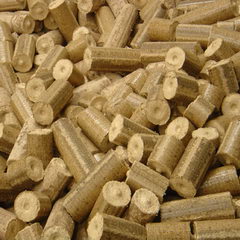wood briquettes

Wood briquettes are a form of solid biofuel consisting of compressed sawdust, often cylindrical in form with a diameter of more than 25 millimeters (1 inch), and usually in the range 50 to 100 millimeters. In length, they range from 60 to 120 millimeters. Compositionally they are like wood pellets, the main difference being one of size: wood pellets for domestic use are typically 6–8 millimeters in diameter and for industrial use 10–12 millimeters in diameter. Like wood pellets, wood briquettes are manufactured at high pressure which causes the lignin in the sawdust to soften and bind together.
The combination of low moisture content (8 to 10%) and high compaction (about 1,000 kilograms per cubic meter) gives both briquettes and pellets a high energy density (i.e., energy content per unit volume) – approximately three to four times that of wood chips. Good quality briquettes and pellets burn cleanly and evenly, making them particularly attractive for use in the home.
Whereas wood pellets are burned in pellet stoves, briquettes are used in conventional wood stoves as a cleaner, more evenly burning alternative to logs, which they resemble in size and shape. The higher energy density of briquettes also means that, for the same amount of heating capacity, they occupy much less storage space than conventional logs.
Wood briquettes come in two main types, one with a hole down the middle, the other which is solid. The difference in appearance is a result of the different methods used to produce them. Briquettes with holes are made with a screw press, the hole being the result of the screw passing through their length. Solid briquettes are formed using a piston press which sandwiches layers of sawdust together. The briquettes with holes have the advantage that the central cavity increases the surface area and thus aids efficient combustion.
Wood briquettes are a particular form of biomass briquettes.
